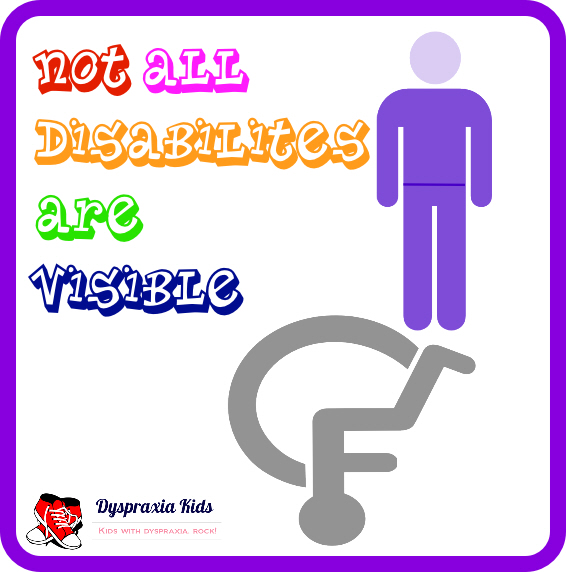Although I don’t usually refer to dyspraxia as a disability, technically speaking it is a disability of sorts. It is a hidden, or invisible, disability. I prefer to call it a disorder.
Dyspraxia is not a learning difficulty as it affects a child physically as well as mentally. Although dyspraxia often likes to hang out with learning difficulties/disabilities* to keep it company–it’s selfish like that. So a child with dyspraxia may also have ADD/ADHD, dyslexia, dyscalculia…
 The reason I don’t like to refer to dyspraxia as a straight out disability is that with the right approach and plenty of practice, most problems that face a child with dyspraxia can be overcome and that can’t be said for someone who has a visible disability.
The reason I don’t like to refer to dyspraxia as a straight out disability is that with the right approach and plenty of practice, most problems that face a child with dyspraxia can be overcome and that can’t be said for someone who has a visible disability.
A child in a wheelchair won’t be able to walk if they have a lot of practice, but a child with dyspraxia can take part in sport, learn to tie shoelaces, and learn to write legibly given time. This is an extreme example, but you get the idea.
The outlook for someone with dyspraxia improves all the time. The more a task is carried out, the more the pathway of the brain cells becomes natural–you have to teach the cells the correct path to take.
In some countries such as the USA, dyspraxia is also referred to as a motor learning disability–which actually makes way more sense! I guess we like to complicate things in the UK.
What Dyspraxia Is
- A condition
- A disorder
- A hidden disability
- Impairment or immaturity of the brain
- A motor learning disability (in some countries)
What Dyspraxia Isn’t
- A learning difficulty
- Something a child ‘suffers’ from
- A disease
A Frustrating Condition
 Dyspraxia is a particularly frustrating condition/disability/disorder as it affects the child both mentally and physically. Dyspraxia is thought to be caused by a problem with the development of the brain.
Dyspraxia is a particularly frustrating condition/disability/disorder as it affects the child both mentally and physically. Dyspraxia is thought to be caused by a problem with the development of the brain.
The pathways from the brain to the muscles are wiggly or unordered, rather than travelling in a naturally smooth way, resulting in uncoordinated physical movements. This applies to both fine and gross motor skills; so sports, handwriting, and tying shoelaces are all much more difficult for a child with dyspraxia.
But this unordered way in which the brain of a dyspraxic works also means that they have problems with mental activities such as task sequencing, maths, puzzles, and remembering detailed instructions. Anything that requires an ordered and logical approach proves difficult for a child with dyspraxia.
Learn More About Dyspraxia
Now you know a bit more dyspraxia being a disability, you might also be interested in our other introductory articles on dyspraxia:
* The terms learning disability and learning difficulty are used depending on which country you are in. Just to confuse us! But once again, dyspraxia is neither of these.

Our child of 7 has dyspraxia, when is a good time to discuss it with them. He has extra help at school amNd senses he is different but we don’t want to ‘label’ him. Not sure when to have the conversations.
I didn’t ever sit my daughter down and have a talk about it as it would be like making a big announcement like she has an illness or something. I only use the label with school etc. to make sure she gets the help she needs. She understands dyspraxia but she’s not going around using it as a label. I think I just mentioned it casually one day when she was having a clumsy day and said “oh silly dyspraxia!” and then she was intrigued and I just explained it simply. That was probably when she was about 7. That was really it. I also got her the book “You’re So Clumsy Charley” which is perfect for a seven-year-old. It doesn’t use the label either but the kids identify with the main character and see that it’s OK to be different. Don’t know if that helps or not really. I don’t think there’s a right or wrong answer. Good luck.